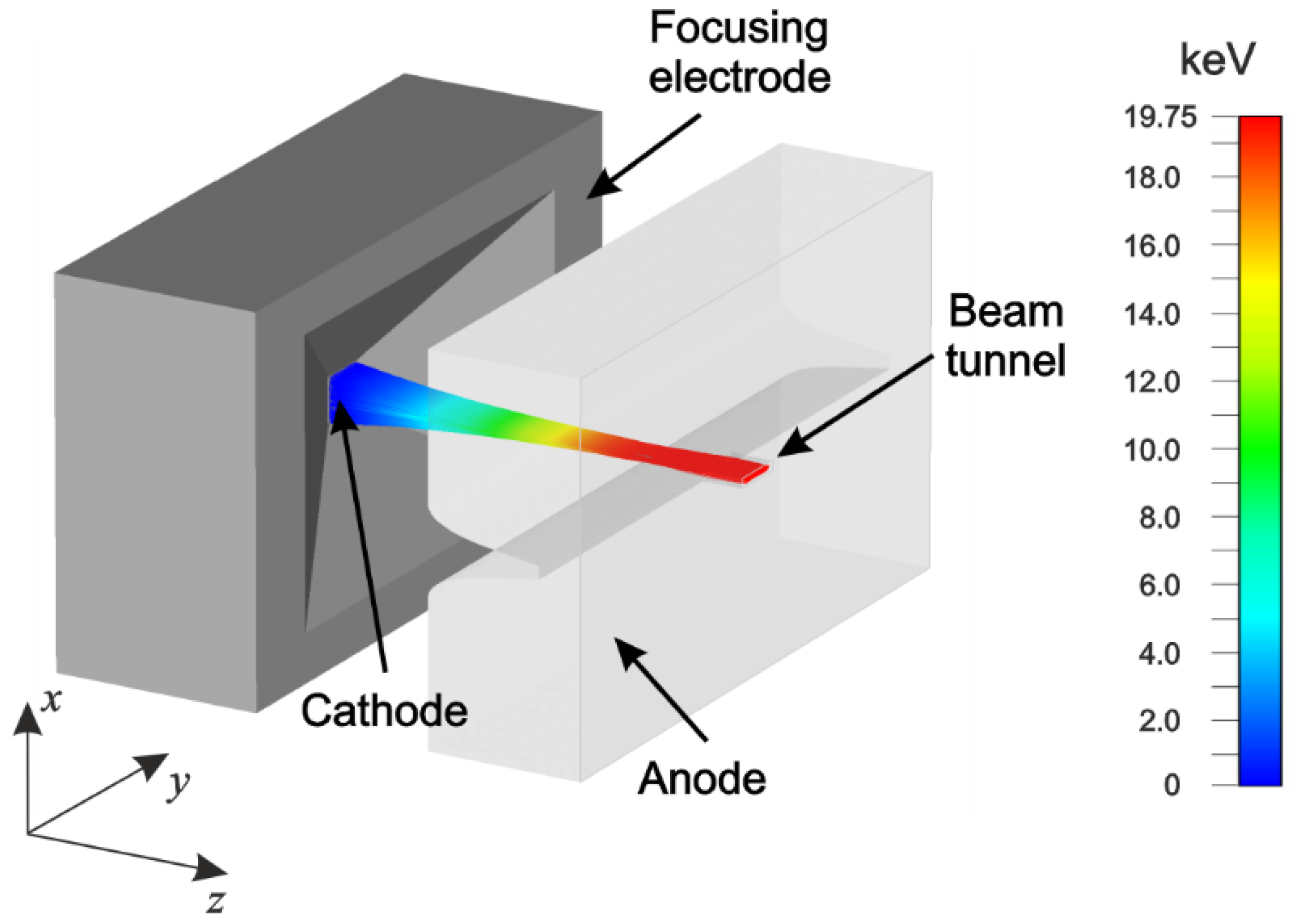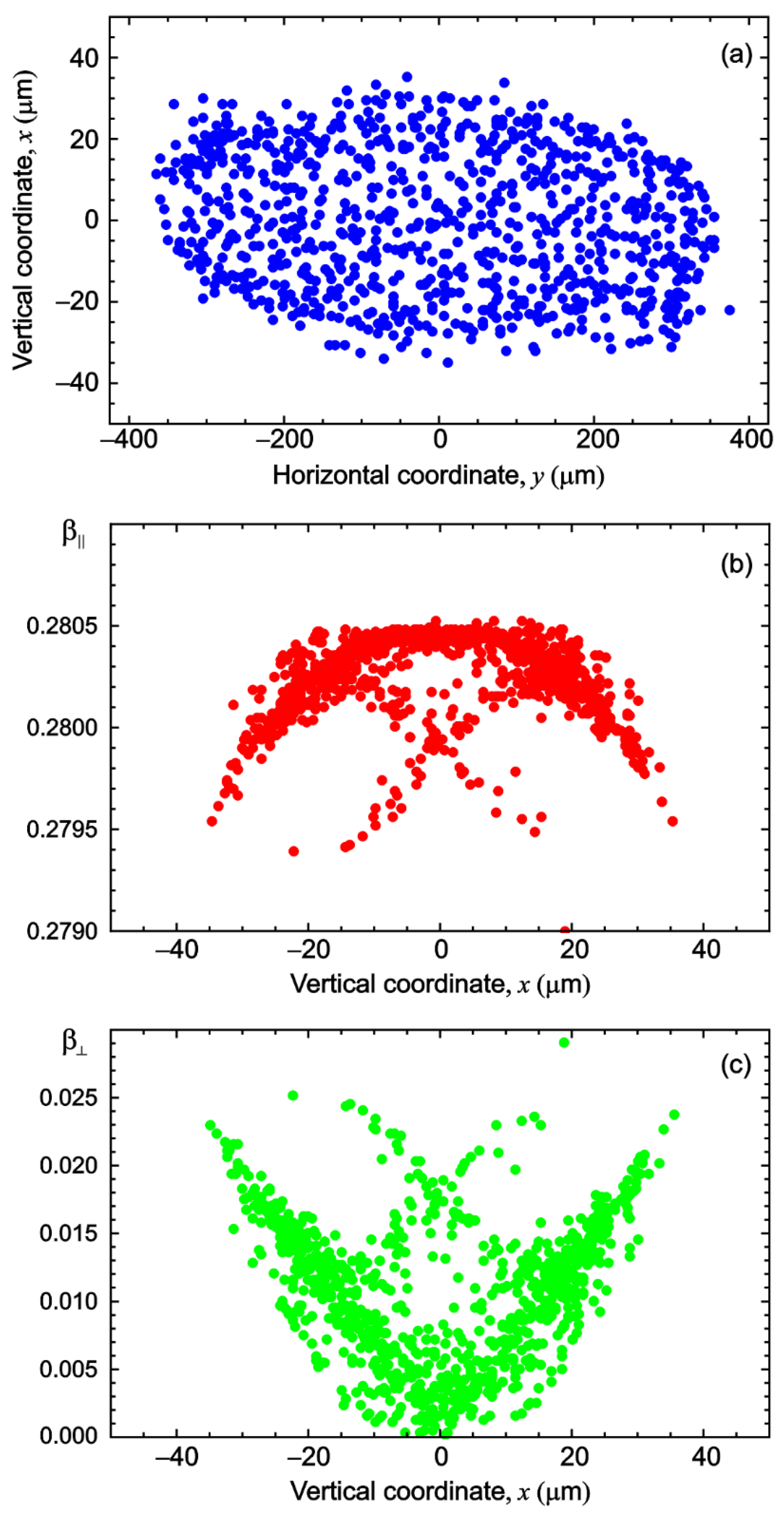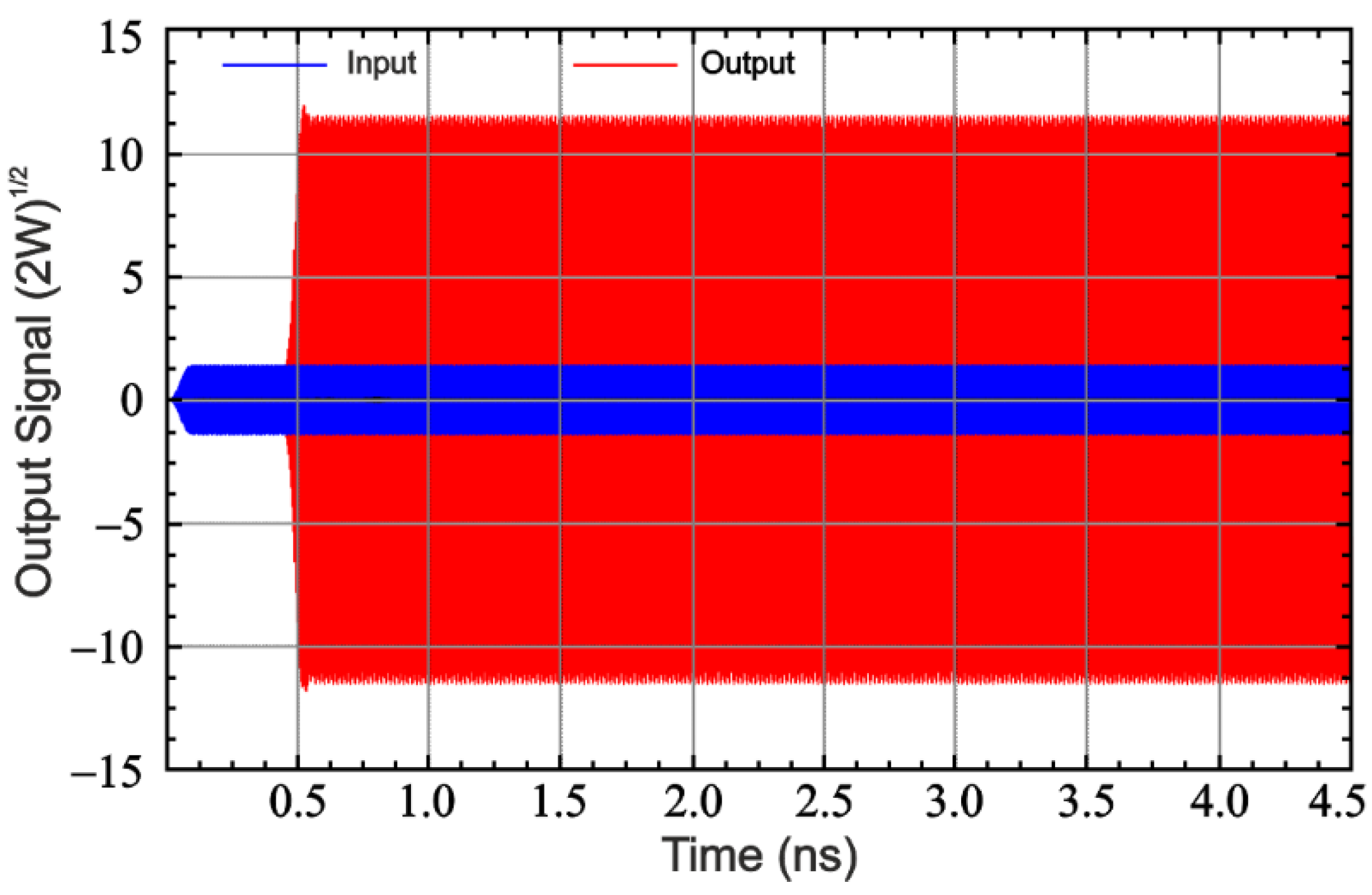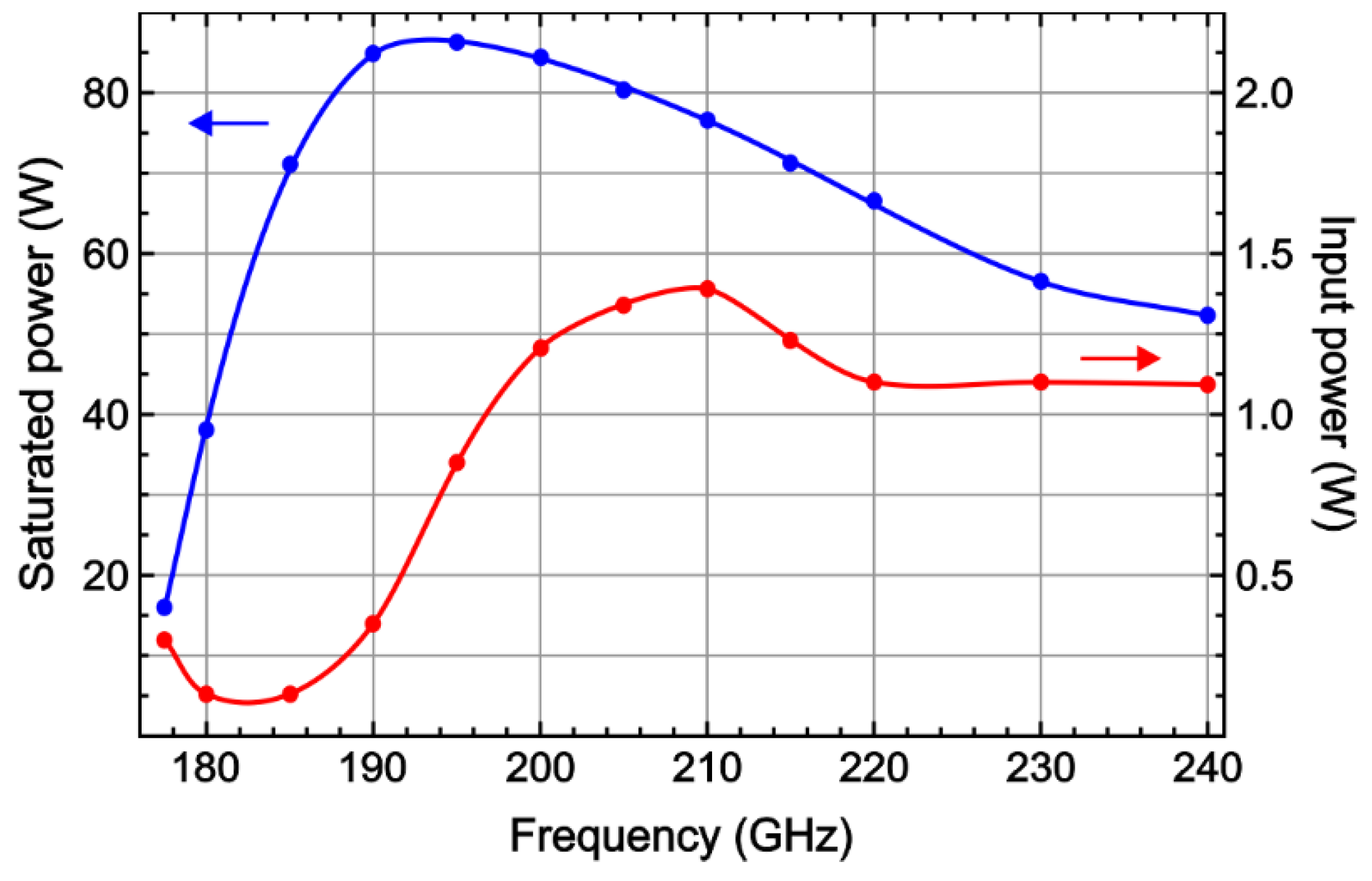Study of Beam–Wave Interaction in a Sub-THz Traveling Wave Tube with a Converging Sheet Electron Beam Focused by a Uniform Magnetic Field
Abstract
1. Introduction
2. Electron Gun Design
3. SWS Design and Modeling
4. Beam–Wave Interaction
5. Conclusions
Author Contributions
Funding
Data Availability Statement
Conflicts of Interest
References
- Paoloni, C. Sub-THz wireless transport layer for ubiquitous high data rate. IEEE Commun. Mag. 2021, 59, 102–107. [Google Scholar] [CrossRef]
- Paoloni, C.; Gamzina, D.; Letizia, R.; Zheng, Y.; Luhmann, N.C. Millimeter wave traveling wave tubes for the 21st century. J. Electromag. Waves Appl. 2021, 35, 567–603. [Google Scholar] [CrossRef]
- Shin, Y.-M.; Baig, A.; Barnett, L.R.; Tsai, W.-C.; Luhmann, N.C. System design analysis of a 0.22-THz sheet-beam traveling-wave tube amplifier. IEEE Trans. Electron Devices 2012, 59, 234–240. [Google Scholar] [CrossRef]
- Rozhnev, A.G.; Ryskin, N.M.; Karetnikova, T.A.; Torgashov, G.V.; Sinitsyn, N.I.; Shalayev, P.D.; Burtsev, A.A. Studying characteristics of the slow-wave system of the traveling-wave tube with a sheet electron beam. Radiophys. Quantum Electron. 2014, 56, 542–553. [Google Scholar] [CrossRef]
- Wang, J.; Shu, G.; Liu, G.; Yang, L.Y.; Luo, Y. Ultrawideband coalesced-mode operation for a sheet-beam traveling-wave tube. IEEE Trans. Electron Devices 2016, 63, 504–511. [Google Scholar] [CrossRef]
- Baig, A.; Gamzina, D.; Kimura, T.; Atkinson, J.; Domier, C.; Popovic, B.; Himes, L.; Barchfeld, R.; Field, M.; Luhmann, N.C. Performance of a nano-CNC machined 220-GHz traveling wave tube amplifier. IEEE Trans. Electron Devices 2017, 64, 2390–2397. [Google Scholar] [CrossRef]
- Field, M.; Kimura, T.; Atkinson, J.; Gamzina, D.; Luhmann, N.C.; Stockwell, B.; Grant, T.J.; Griffith, Z.; Borwick, R.; Hillman, C.; et al. Development of a 100-W 200-GHz high bandwidth mm-wave amplifier. IEEE Trans. Electron Devices 2018, 65, 2122–2128. [Google Scholar] [CrossRef]
- Karetnikova, T.A.; Rozhnev, A.G.; Ryskin, N.M.; Fedotov, A.E.; Mishakin, S.V.; Ginzburg, N.S. Gain analysis of a 0.2-THz traveling-wave tube with sheet electron beam and staggered grating slow wave structure. IEEE Trans. Electron Devices 2018, 65, 2129–2134. [Google Scholar] [CrossRef]
- Burtsev, A.A.; Danilushkin, A.V.; Navrotsky, I.A.; Ploskih, A.E.; Ryskin, N.M.; Titov, V.N. Studies on sub-THz sheet-beam TWT with staggered grating slow-wave structure. In Proceedings of the 2019 International Vacuum Electronics Conference (IVEC), Busan, Republic of Korea, 28 April–1 May 2019. [Google Scholar] [CrossRef]
- Ploskih, A.E.; Ryskin, N.M.; Burtsev, A.A.; Danilushkin, A.V.; Navrotsky, I.A. Performance improvement of a sub-THz traveling-wave tube by using an electron optic system with a converging sheet electron beam. Res. Phys. 2019, 12, 799–803. [Google Scholar] [CrossRef]
- Shu, G.; Deng, J.; Xie, L.; Liu, G.; Zhang, L.; Wang, J.; Qian, Z.; He, W. Design, fabrication, and cold test of a high frequency system for an H-band sheet beam travelling wave tube. IEEE Trans. Terahertz Sci. Technol. 2020, 10, 292–301. [Google Scholar] [CrossRef]
- Lu, Z.; Ge, W.; Wen, R.; Wang, Z.; Gong, H.; Wei, Y.; Gong, Y. 0.2-THz traveling wave tube based on the sheet beam and a novel staggered double corrugated waveguide. IEEE Trans. Plasma Sci. 2020, 48, 3229–3237. [Google Scholar] [CrossRef]
- Wan, Y.; Wang, J.; Liu, Q.; Li, X.; Wu, Z.; Liu, G.; Luo, Y. A high-power sheet beam slow-wave structure of traveling wave tubes. IEEE Electron Device Lett. 2001, 42, 747–750. [Google Scholar] [CrossRef]
- Gamzina, D.; Himes, L.G.; Barchfeld, R.; Zheng, Y.; Popovic, B.K.; Paoloni, C.; Choi, E.M.; Luhmann, N.C. Nano-CNC machining of sub-THz vacuum electron devices. IEEE Trans. Electron Devices 2016, 63, 4067–4073. [Google Scholar] [CrossRef]
- Srivastava, A.; So, J.-K.; Wang, Y.; Wang, J.; Raju, R.S.; Han, S.-T.; Park, G.-S. Design of sheet-beam electron gun with planar cathode for terahertz devices. J. Infrared Millim. Teraherz Waves 2009, 30, 670–678. [Google Scholar] [CrossRef]
- Zheng, Y.; Gamzina, D.; Popovic, B.; Luhmann, N.C. Electron beam transport system for 263-GHz sheet beam TWT. IEEE Trans. Electron Devices 2016, 63, 4466–4472. [Google Scholar] [CrossRef]
- Wang, S.; Aditya, S.; Miao, J.; Xia, X. Design of a sheet-beam electron-optical system for a microfabricated W-band traveling-wave tube using a cold cathode. IEEE Trans. Electron Devices 2016, 63, 3725–3732. [Google Scholar] [CrossRef]
- Yang, L.; Wang, J.; Li, H.; Jiang, W.; Dong, K.; Luo, Y. Study of a novel bidirectional compression electron gun for W-band sheet beam TWT. IEEE Trans. Plasma Sci. 2017, 45, 805–810. [Google Scholar] [CrossRef]
- Navrotsky, I.A.; Burtsev, A.A.; Emelyanov, V.V.; Titov, V.N.; Ryskin, N.M. Electron-optic system with a converged sheet electron beam for a 0.2-THz traveling-wave tube. IEEE Trans. Electron Devices 2021, 68, 798–803. [Google Scholar] [CrossRef]
- Ploskikh, A.E.; Titov, V.N.; Ryskin, N.M. Design study of a sub-THz traveling wave tube with a converging sheet electron beam. In Proceedings of the 2021 14th UK-Europe-China Workshop on Millimetre-Waves and Terahertz Technologies (UCMMT), Lancaster, UK, 13–15 September 2021. [Google Scholar] [CrossRef]
- CST Studio Suite Electromagnetic Field Simulation Software; Dassault Systèmes Deutschland GmbH. Available online: https://www.3ds.com/products-services/simulia/products/cst-studio-suite (accessed on 13 November 2022).
- Comsol Multiphysics Engineering Simulation Software; COMSOL Inc.: Burlington, MA, USA, 2020; Available online: https://www.comsol.com/comsol-multiphysics (accessed on 13 November 2022).
- Hammerstad, E.; Jensen, O. Accurate models for microstrip computer-aided design. In Proceedings of the 1980 IEEE MTT-S International Microwave Symposium Digest, Washington, DC, USA, 28–30 May 1980; pp. 407–409. [Google Scholar] [CrossRef]
- Cook, A.M.; Joye, C.D.; Kimura, T.; Wright, E.L.; Calame, J.P. Broadband 220-GHz vacuum window for a traveling-wave tube amplifier. IEEE Trans. Electron Devices 2013, 60, 1257–1259. [Google Scholar] [CrossRef]
- Yang, T.; Guan, X.; Fu, W.; Lu, D.; Zhang, C.; Xie, J.; Yuan, X.; Yan, Y. Over-size pill-box window for sub-terahertz vacuum electronic devices. Electronics 2021, 10, 653. [Google Scholar] [CrossRef]
- Proyavin, M.D.; Sobolev, D.I.; Parshin, V.V.; Belousov, V.I.; Mishakin, S.V.; Glyavin, M.Y. Study of 3D-printed dielectric barrier windows for microwave applications. Electronics 2021, 10, 2225. [Google Scholar] [CrossRef]
- Bai, N.; Shen, J.; Fan, H.; Sun, X.; Pan, P.; Cai, J.; Yu, W.; Feng, J. A broad bandwidth metamaterial pillbox window for W-band traveling-wave tubes. IEEE Electron Device Lett. 2021, 42, 1228–1231. [Google Scholar] [CrossRef]











| Parameter | Value (μm) |
|---|---|
| Period of the structure, p | 500 |
| Vane thickness, s | 100 |
| Vane height, l | 300 |
| Beam tunnel height, 2a | 100 |
| Width of the structure, b | 850 |
Publisher’s Note: MDPI stays neutral with regard to jurisdictional claims in published maps and institutional affiliations. |
© 2022 by the authors. Licensee MDPI, Basel, Switzerland. This article is an open access article distributed under the terms and conditions of the Creative Commons Attribution (CC BY) license (https://creativecommons.org/licenses/by/4.0/).
Share and Cite
Titov, V.; Ploskih, A.; Ryskin, N. Study of Beam–Wave Interaction in a Sub-THz Traveling Wave Tube with a Converging Sheet Electron Beam Focused by a Uniform Magnetic Field. Electronics 2022, 11, 4208. https://doi.org/10.3390/electronics11244208
Titov V, Ploskih A, Ryskin N. Study of Beam–Wave Interaction in a Sub-THz Traveling Wave Tube with a Converging Sheet Electron Beam Focused by a Uniform Magnetic Field. Electronics. 2022; 11(24):4208. https://doi.org/10.3390/electronics11244208
Chicago/Turabian StyleTitov, Vladimir, Andrey Ploskih, and Nikita Ryskin. 2022. "Study of Beam–Wave Interaction in a Sub-THz Traveling Wave Tube with a Converging Sheet Electron Beam Focused by a Uniform Magnetic Field" Electronics 11, no. 24: 4208. https://doi.org/10.3390/electronics11244208
APA StyleTitov, V., Ploskih, A., & Ryskin, N. (2022). Study of Beam–Wave Interaction in a Sub-THz Traveling Wave Tube with a Converging Sheet Electron Beam Focused by a Uniform Magnetic Field. Electronics, 11(24), 4208. https://doi.org/10.3390/electronics11244208







